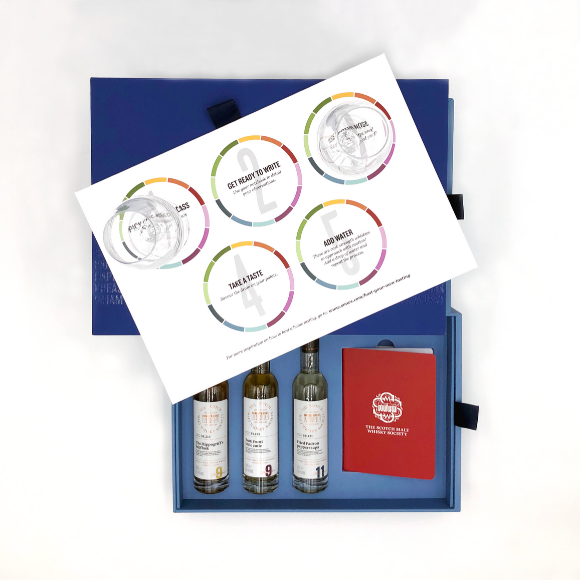Dallas Dhu
First Society bottling in 1987.
Dallas Dhu is unique among Scotland's distilleries, in that although it last produced spirit in 1983, it has been preserved in full working order by Historic Scotland, and could begin distilling again at short notice, though that seems unlikely ever to happen. That it ceased distilling at all is a matter of some sadness, for while the make of some of the twenty-one plants which the Distilleries Company Limited closed during the 1980's was, frankly, far from excellent,
Dallas Dhu enjoyed a high reputation as a single malt. Jim Murray (Complete Book of Whisky) describes it as a ' ... labyrinthine roast coffee-ish malt', and considers it ' ... easily the finest made in this part of Scotland and possibly one of the top ten in the country.' Dallas Dhu distillery is situated just over a mile south of the ancient borough of Forres in Morayshire, and was built on the estate of Alexander Edward for the Glasgow blending company of Wright & Greig Ltd.
Originally intended to called Dalasmore, the distillery was probably given the 'dhu' prefix because Wright and Greig produced the popular blended whisky Roderick Dhu, named after a character in Sir Walter Scott's The Lady of the Lake. Dallas Dhu is Gaelic for 'blackwater valley', and the distillery lies six miles from the small village of Dallas, which gave its name to the somewhat less sleepy Texas oil city in 1845 by way of US vice president George Dallas, a descendant of William de Ripley, who owned the Morayshire settlement in the 13th century. Alexander Edward was an enthusiastic whisky entrepreneur, who inherited Benrinnes distillery from his father, and subsequently became involved with Craigellachie and Aultmore.
In addition to Dallas Dhu, Benromach distillery was also built on his estate. For a time during the 1980s it looked as though Forres' connection with distilling would be totally severed, as both Dallas Dhu and Benromach closed, but Benromach is now distilling again in the hands of the Elgin whisky merchant Gordon & MacPhail, while Dallas Dhu plays a valuable role in the whisky heritage business, attracting around eighteen thousand visitors per year. Dallas Dhu distillery was close to major barley-growing areas, and was served by the Highland Railway's Aviemore to Forres line.
It was designed by the Elgin architect and distillery specialist Charles Doig, and construction commenced in 1898, with the first spirit flowing from its pair of stills the following year. Thus Dallas Dhu began producing just as the 1890's whisky boom which saw nineteen new Speyside distilleries constructed in five years, turned to bust, though Wright & Greig Ltd survived until 1919 before succumbing to voluntary liquidation. The distillery subsequently passed into the hands of Benmore Distilleries Ltd, who owned two plants in Campbeltown, and the Lochindaal distillery on Islay. The downturn in demand for Campbeltown whiskies forced the company to sell out to DCL, however, and Dallas Dhu was closed from 1929 until 1936, when it reopened under the auspices of the DCL subsidiary Scottish Malt Distillers.
The distillery continued to be licensed to Benmore Distilleries Ltd until its closure in 1983, and it is the Benmore name which today's visitors see above the distillery office door. Fire gutted the stillhouse and caused a total of ??7,000 worth of damage in April 1939, and though repairs were soon completed, the distillery was silent during the Second World War, with distilling recommencing in 1947 to satisfy the post-war thirst for whisky around the world. By 1983, that thirst had turned into a 'whisky loch', however and Dallas Dhu was one of eleven distilleries axed by DCL in May of that year in a move to cut over-production.
In 1986 the company handed over Dallas Dhu to the Secretary of State for Scotland, and the distillery was subsequently developed to allow public access and to provide interpretative facilities within the existing physical framework.
One of the advantages of a visit to Dallas Dhu is that the absence of a human guide with one eye on the clock allows the opportunity to absorb the processes of whisky making at one's own pace, and the mechanics of distillation become clearer than during many tours of working distilleries. The fact that Dallas Dhu was not significantly expanded and upgraded during periods of prosperity in the industry allows us a rare chance to gain a sense of how a small Speyside distillery would have been a century ago, but it also contributed to DCL's decision to close it in the 1980's. Although the distillery had a reliable source of water in the Altyre Burn, supplies were not sufficient in capacity to allow significant expansion.
New stills were installed in 1963, and a decade later the automatic coal-firing system was replaced with steam heating, but otherwise Dallas Dhu remains very close to its original state. Dallas Dhu is bottled by UDV in their 'Rare Malts' range, and is also available in independent bottlings.
The Roderick Dhu blend survives, and may be purchased from the distillery shop, which also offers a wide range of souvenir items and an excellent, truly informative, guidebook. Further information about Dallas Dhu and details of the opening hours may be obtained by phoning 01309 676548. Gavin Smith is a freelance writer who specialises in whisky and horse-racing. He lives in Perth.

